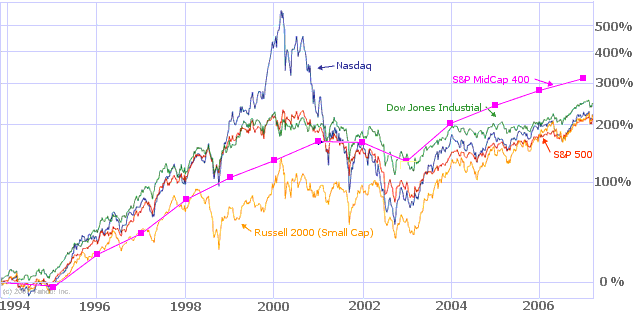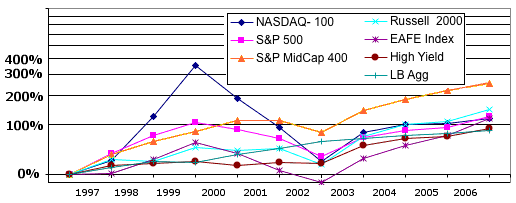|
|
Under Construction 
Contents: | ||||||||||||||||||||||||||||||
|
Daily News: money.cnn.com Bloomberg.com Yahoo Finance Google Finance MarketWatch.com TheStreet.com Financial Times Wall Street Journal Investor's Business Daily Forbes Breaking News AP Breaking News at BusinessWeek AG Edwards Market Monitor Fidelity Markets & Sectors Weekley - Monthly News: Money Magazine at money.cnn Barrons Business Week Forbes Investement Guidance: Motley Fool |
Blogs: Seeking Alpha Bill Cara CXO Advisory Group - Steve LeCompte Random Roger's Big Picture The Kirk Report 2005 Best Financial BLogs at CNN Money BobKronish.blogspot.com/
Other: | |||||||||||||||||||||||||||||
|
Where to get good advice:
The QXO Advisory Group (Steve LeCompte) tabulates the market forecasts of 42 major market commentators and forecasters. The top forecasters as of June, 2007 were Ken Fisher in Forbes, David Nassar, Louis Navellier and James Oberweis at MarketWatch.com and Jack Schannep at zacks.com, and Jason kelly at JasonKelly.com with 60-72% accuracy. Only 18 were better than 50% and 24 were accurate only half or less of the time. The Hulbert Financial Digest (HFD) tracks the performance of over 180 investment newsletters. Jim Cramer's Mad Money picks can move a stock up in the short run, but according to CramerWatch.org, after 30 days he is right only 49% of the time.
Value Line is a service that ranks stocks from 1 to 5 for timeliness. They claim their recommendations beat the market, however the Value Line Fund, which uses the Value Line ranking system to direct its stock picks has churned out so-so performance numbers relative to other large-growth funds.
Mutual Funds:
An 2001 A.G. Edwards study illustrated the unpredictable
nature of money manager performance.
Why don't Mutual Funds beat the market?
A Bernstein GLobal Wealth Management Report in 2003 says:
According to the International Herald Tribune in 1995: Some reasons for underperformance:
The advantage is you get diversification with a small (<$100,000) portfolio.
See:
What drives the markets: I've heard that hedge funds account for 1/3 of the trading.
Logarithmic Charts
Note: The indexes do not include dividends, which for the S&P average about 2%/year so your actual gain would be higher.
Bear Markets
Sub-prime lending market problems in Sept. 2007,
the longest profit slump in six years, the first nationwide decrease in home prices since the Great Depression, record oil prices and fears of a recession resulted the worst bear market in recent history.
Over the weekend and on Monday, Sept. 15, 2008 Merrill Lynch, one of the biggest and best-known brokerage firms in the world, was sold to Bank of America for $50 billion due to financial difficulties stemming from problems in the mortgage markets. Lehman Brothers, unable to find a buyer, filed for bankruptcy . On Wed. the US Federal Reserve struck a deal to take control of AIG in return for an $85bn loan to stave off a collapse of the giant.
After congress passed a $700 B bail-out bill to help the financial credit crunch, credit markets remained frozen.
The week of Oct. 6-10 was the worst week in history point wise when the Dow dropped 1,874 points or 18.2% 2nd worst percent loss since the 1929 depression. See 2008 Recession for more. Big days (Since 1950): DJIA: Largest Daily Loss 777 7.0% Sept. 29, 2008 DJIA: Daily Loss 685 7.1% Sept. 17, 2001 DJIA: Daily Loss 679 7.3% Oct. 9, 2008 DJIA: Daily Loss 618 5.7% April 14, 2000 DJIA: Largest percent Loss 22.6% October 19, 1987 (black Monday) DJIA: Largest gain 936 11.1% October 13, 2008 * DJIA: 2nd Largest Daily Gain 889 10.9% October 28, 2008 DJIA: 2nd Largest Daily Gain 499 March 16, 2000 DJIA: 3rd Largest % Gain 187 10.2% Oct 21, 1987 * The 11 % gain in Oct., 2008 was bigest since Sept. 1932 (11.4%) or March of 1933 (15.3%) and the fourth-best overall.See Bear Markets
NYSE Market Cap A 2007 article at cross-currents.net talks about how we have turned from investors to traders with the dollar trading volume (DTV) up 18% in 2007 Linear Charts are available on another page.
| ||||||||||||||||||||||||||||||
Other Indices: This chart demonstrates the volatility of Nasdaq relative to the other indexes. The Dow Jones Industrial is the only major indicator (Dow, Nasdaq, S&P) which had recovered from the 2000-2002 bear market 4 1/2 years later (as of March 2007), as people moved to more defensive stocks. (Note: It appears the numbers below do NOT include dividends)
See other indexes on the asset allocation page See: A Fool's Guide to Indexes
Other Indexes:
Relative performance of Bond funds and International: | |||||||||||||||||||||||||||||||||||||||||||||||||||||||||||||||||||||||||||||||||||||||||||||||||||||||||||||||||||||||||||||||||||||||||
| MSCI EAFE Index of international equity performance. Lehman Aggregate Bond Index (AGG) covers the investment-grade, fixed-rate, taxable bond market. Merrill Lynch High Yield Master II Index of high yield Corporate bonds. See indexes on the asset allocation page |
10 Year (See also 15 year chart) | ||||||||||||||||||||||||||||||||||||||||||||||||||||||||||||||||||||||||||||||||||||||||||||||||||||||||||||||||||||||||||||||||||||||||
|
S&P 500 - Widely regarded as the best single gauge of the U.S. equities market, it includes a representative sample of 500 leading companies in leading
industries of the U.S. economy, and focuses on the large-cap segment of the
market. The median capitalization size of companies in the S&P 500 is
approximately $13.2 billion.*
Nasdaq 100 Index - 100 of the largest domestic and international non-financial securities listed on The Nasdaq Stock Market, based on market capitalization. The index reflects companies across major industry groups including computer hardware and software, telecommunications, retail/wholesale trade and biotechnology. The S&P MidCap 400 is the most widely used index for mid-sized companies (mid-caps). Today mid-caps are being recognized as an independent asset class, with risk/reward profiles that differ considerably from both large-ca ps and small-caps. The median capitalization of the S&P 400 companies is $2.7 billion. The Russel 2000® small-cap Index - Measures is the standard small cap index. It includes the 2,000 smallest companies in the Russell 3000 Index. The index is completely reconstituted annually to ensure larger stocks do not distort the perfor mance and characteristics of the tr ue small-cap opportunity set. The median market capitalization of the Russell 2000 Index is $657 million.* 4Q 2006
Risk - Volatility:
Standard Deviation is one measure of volitility
Volitility reduces long term return E.g. if you invest $100 and get 20% the 1st year ($120) and -10% the 2nd year ($108) your average return is 5% but the compounded return is 3.9% 5% compounded would give you $110.25 Alpha, Beta and Sharpe Ratio are other measures of volitility. See the Glossary page. 1. Risk in long term debt securities (bonds, T-bills) is higher because you are locked into a rate for a longer period of time and price will drop as interest rates go up.
Economic Indicators:
See Macro Economics for some general ideas on economics.
Strategies:
Investment Styles at axaonline.com Blog Synthesis: Individual Investing at QXO Advisory. What's Ahead for Stocks and Bonds—And How to Earn Your Fair Share, by John C. Bogle Founder and Former Chairman, The Vanguard Group
Types of investements:
† SPDR (Standard & Poor's Depository Receipts) Symbol: SPY, the ETF tracking the S&P 500 index, is more commonly referred to as spider. ‡ IJR - iShares S&P SmallCap 600 Index
ETFs (Exchange Traded Funds) vs Index Funds.
A common statistic is that the S&P 500 outperforms 80% of mutual funds. While this stat is true in some years, it's not always the case.
Inverse Funds:
The investment advisors who offer free lunches to retired people usually push
equity indexed annuities (EIA) and Insurance.
EIAs have a value tied to a stock index but an minimum return (usually around 3%) and a cap on gians, so they are attractive if you are worried about a stock market decline. However, there are usually caps, spreads, margains and crediting methods that can hinder returns and penalties if you cash in early e.g. less than 5 years. They usually have high comission rates also.
Other Links:
Where to get good advice:
Sample commentaries: See Macro Economics for Financial terms (GDP, CPI, ...) Books: The Only Three Questions that Count, 2006, Ken Fisher Unconventional Success: A Fundamental Approach to Personal Investing by David Swenson. Review The Number" by Lee Eisenberg "The Rules of Risk" by Ron Dembo and Andrew Freeman "All About Asset Allocation" by Richard Ferri "More Than You Know" by Michael Mauboussin "Ahead of the Curve" by Joseph Ellis Glossary: See Glossary page.
Links:
Asset Allocation
Return to Finance Send comments and suggestions to | |||||||||||||||||||||||||||||||||||||||||||||||||||||||||||||||||||||||||||||||||||||||||||||||||||||||||||||||||||||||||||||||||||||||||